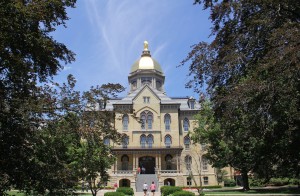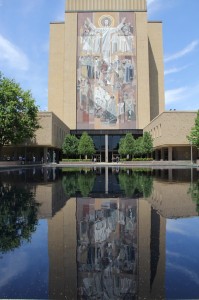 It isn’t often that all of the furnishings in a historic home are original to the house, especially a 38-room, 12,000 square foot mansion. That’s what you’ll see when you tour the Oliver Mansion in South Bend, Indiana, immersing you in the lavish lifestyle of its owners, the J.D. and Anna Oliver family, as it was in the 1930s.
It isn’t often that all of the furnishings in a historic home are original to the house, especially a 38-room, 12,000 square foot mansion. That’s what you’ll see when you tour the Oliver Mansion in South Bend, Indiana, immersing you in the lavish lifestyle of its owners, the J.D. and Anna Oliver family, as it was in the 1930s.
J.D. Oliver’s father James immigrated to the United States with his family from Scotland when he was 12 years old. He took a job working on a farm where he became familiar with plows. As an adult James was a partner in the South Bend Iron Company and experimented with improving the field plow. He registered 45 patents on improved plow design during his lifetime. The company flourished, and James Oliver became wealthy. J.D. eventually took over as President of the company. By that time the company name had been changed to Oliver Chilled Plow Works.
 J.D. married Anna in 1885, and in 1886 they moved into their new Indiana fieldstone Romanesque Queen Anne home. The Olivers had four children, and as the family grew, so did the Oliver Chilled Plow Works, becoming the largest plow factory in the world at the turn of the century. The family lived lavishly, were socially active and also deeply involved in community service. The family’s community service continued through the generations, as J.D. and Anna’s grandchildren donated the mansion and its furnishings to South Bend’s Center for History.
J.D. married Anna in 1885, and in 1886 they moved into their new Indiana fieldstone Romanesque Queen Anne home. The Olivers had four children, and as the family grew, so did the Oliver Chilled Plow Works, becoming the largest plow factory in the world at the turn of the century. The family lived lavishly, were socially active and also deeply involved in community service. The family’s community service continued through the generations, as J.D. and Anna’s grandchildren donated the mansion and its furnishings to South Bend’s Center for History.
Don’t miss a Midwest Wanderer post. For a FREE subscription, enter your e-mail address in the Subscribe2 box to the left and click Subscribe.
The home is set up as a working house in the 1930s. Though daughter Catherine, who never married and lived out her life in the mansion, sold or gave away furnishings, recipients of those items have returned many of them.
Each of the 14 fireplaces is different, some more ornate than others.


 Carved woodwork on fireplace hearths, railings, even on the ceilings exude richness.
Carved woodwork on fireplace hearths, railings, even on the ceilings exude richness.


 The office and the game room have especially masculine features.
The office and the game room have especially masculine features.

 Leaded glass windows in several rooms soften the harshness of the dark wood, and fabrics soften the decor in the dining room and music room.
Leaded glass windows in several rooms soften the harshness of the dark wood, and fabrics soften the decor in the dining room and music room.
 The kitchen isn’t as fancy, but it’s spacious, with multiple stoves and plenty of icebox and storage space needed to prepare for large parties.
The kitchen isn’t as fancy, but it’s spacious, with multiple stoves and plenty of icebox and storage space needed to prepare for large parties.

 Catherine lived her adult life mostly on the second floor, which she had redone in green art deco.
Catherine lived her adult life mostly on the second floor, which she had redone in green art deco.
 After J.D. and Anna’s son Joseph’s wife was thrown from a horse and killed, Joseph came back to live in the family home. He stayed mainly on the third floor. His seven shaving brushes, one for each day of the week, are on display in the bathroom.
After J.D. and Anna’s son Joseph’s wife was thrown from a horse and killed, Joseph came back to live in the family home. He stayed mainly on the third floor. His seven shaving brushes, one for each day of the week, are on display in the bathroom.
 Beautifully manicured gardens surround the mansion.
Beautifully manicured gardens surround the mansion.
 Besides the mansion, the tour also includes a look at the Polish workers’ house, less than a five minute walk from the main house. The house, comfortable quarters for the Olivers’ domestic staff, was built in 1851. The Olivers added a bathroom and other conveniences. Like the mansion, the workers’ house is decorated as it would have been in the 1930s.
Besides the mansion, the tour also includes a look at the Polish workers’ house, less than a five minute walk from the main house. The house, comfortable quarters for the Olivers’ domestic staff, was built in 1851. The Olivers added a bathroom and other conveniences. Like the mansion, the workers’ house is decorated as it would have been in the 1930s.

 The History Museum provides tours of the Oliver Mansion seven days a week. The main entrance is shared with the Studebaker National Museum at 897 Thomas Street, South Bend, Indiana. Check the web site for tour times and admission rates.
The History Museum provides tours of the Oliver Mansion seven days a week. The main entrance is shared with the Studebaker National Museum at 897 Thomas Street, South Bend, Indiana. Check the web site for tour times and admission rates.
Disclosure: My visit to the Oliver Mansion was hosted by Visit South Bend Mishawaka and the History Museum, but any opinions expressed in this article are my own. Some of the pbotos were taken by Skip Reed and some by Connie Reed.
Other posts you may enjoy:
Studebaker Museum, South Bend: From Carriages to Automobiles
Touring the University of Notre Dame Campus, South Bend, Indiana
Tour the South Bend Chocolate Company Factory
Shop the South Bend Farmers Market Year Round
Thank you for reading Midwest Wanderer. Don’t miss a post. Enter your e-mail address below and click Subscribe to be notified whenever I publish another post. Subscription is FREE. After subscribing, be sure to click the link when you get the e-mail asking you to confirm. – Connie































